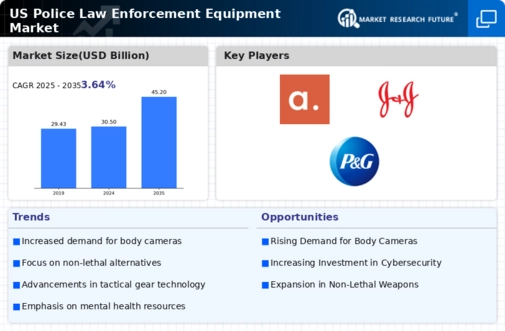Increased Crime Rates
The persistent rise in crime rates across various urban areas in the US appears to be a primary driver for the police law-enforcement-equipment market. Law enforcement agencies are compelled to enhance their operational capabilities to address these challenges effectively. For instance, the FBI reported a 5.6% increase in violent crime in 2021, prompting agencies to invest in advanced equipment. This trend indicates a growing demand for sophisticated tools such as body cameras, surveillance systems, and tactical gear. As crime rates fluctuate, the police law-enforcement-equipment market is likely to experience corresponding growth, with agencies prioritizing investments in technology that can aid in crime prevention and resolution.
Public Safety Initiatives
Public safety initiatives are increasingly influencing the police law-enforcement-equipment market. As communities demand greater accountability and transparency from law enforcement, agencies are investing in equipment that fosters trust and enhances public safety. The implementation of body cameras, for instance, has surged, with many departments reporting a 30% increase in their use over the past few years. These initiatives not only improve community relations but also drive the demand for advanced equipment that supports transparency and accountability. Consequently, the police law-enforcement-equipment market is expected to see sustained growth as agencies align their procurement strategies with public safety objectives.
Technological Advancements
Technological advancements are reshaping the landscape of the police law-enforcement-equipment market. Innovations in areas such as artificial intelligence, data analytics, and communication systems are enabling law enforcement agencies to operate more efficiently. For instance, the integration of AI in surveillance systems has shown to enhance threat detection capabilities significantly. As agencies seek to leverage these technologies, the market is expected to expand, with a projected growth rate of 7% annually over the next five years. This trend suggests that the police law-enforcement-equipment market will continue to evolve, driven by the need for modern solutions to contemporary policing challenges.
Government Funding and Grants
Government funding plays a crucial role in shaping the police law-enforcement-equipment market. Federal and state grants are often allocated to law enforcement agencies to upgrade their equipment and technology. For example, the Department of Justice has provided millions in grants to support the acquisition of body-worn cameras and other essential tools. This financial support not only enhances the operational efficiency of police departments but also encourages the adoption of innovative technologies. As funding opportunities continue to evolve, the police law-enforcement-equipment market is expected to benefit from increased investments, enabling agencies to procure state-of-the-art equipment that meets contemporary law enforcement needs.
Community Engagement and Support
Community engagement initiatives are becoming increasingly vital for law enforcement agencies, thereby impacting the police law-enforcement-equipment market. As agencies strive to build stronger relationships with the communities they serve, there is a growing emphasis on equipment that facilitates interaction and transparency. Programs that involve community input in equipment selection, such as body cameras and non-lethal tools, are gaining traction. This shift not only enhances public trust but also drives demand for specific types of equipment. As community engagement continues to be prioritized, the police law-enforcement-equipment market is likely to adapt, reflecting the evolving needs and expectations of the public.














Leave a Comment